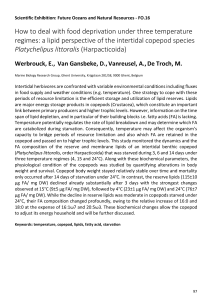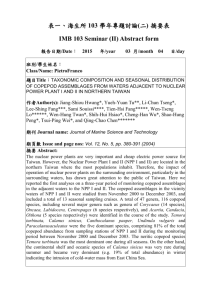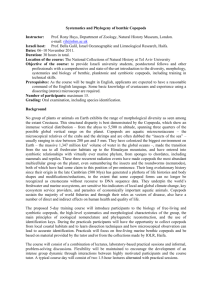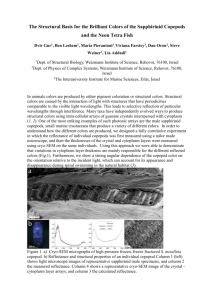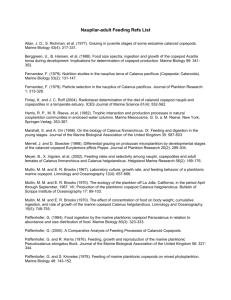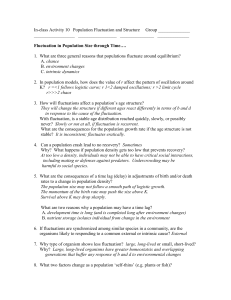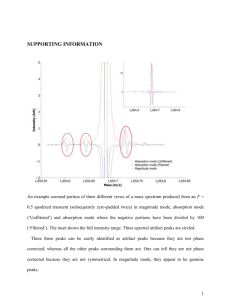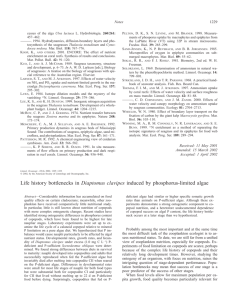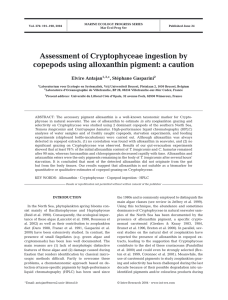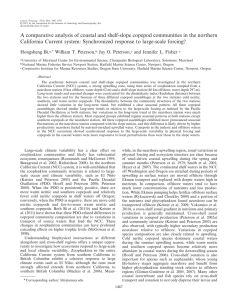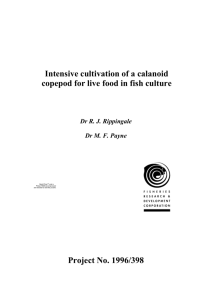Copepod community structure and population dynamics in
advertisement
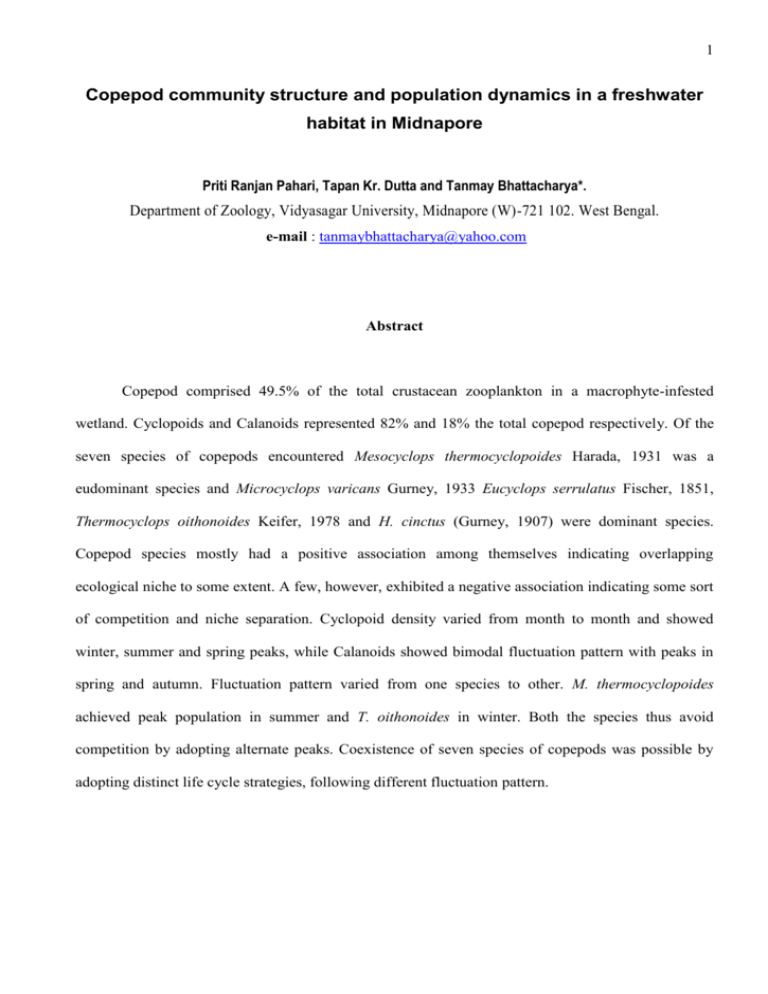
1 Copepod community structure and population dynamics in a freshwater habitat in Midnapore Priti Ranjan Pahari, Tapan Kr. Dutta and Tanmay Bhattacharya*. Department of Zoology, Vidyasagar University, Midnapore (W)-721 102. West Bengal. e-mail : tanmaybhattacharya@yahoo.com Abstract Copepod comprised 49.5% of the total crustacean zooplankton in a macrophyte-infested wetland. Cyclopoids and Calanoids represented 82% and 18% the total copepod respectively. Of the seven species of copepods encountered Mesocyclops thermocyclopoides Harada, 1931 was a eudominant species and Microcyclops varicans Gurney, 1933 Eucyclops serrulatus Fischer, 1851, Thermocyclops oithonoides Keifer, 1978 and H. cinctus (Gurney, 1907) were dominant species. Copepod species mostly had a positive association among themselves indicating overlapping ecological niche to some extent. A few, however, exhibited a negative association indicating some sort of competition and niche separation. Cyclopoid density varied from month to month and showed winter, summer and spring peaks, while Calanoids showed bimodal fluctuation pattern with peaks in spring and autumn. Fluctuation pattern varied from one species to other. M. thermocyclopoides achieved peak population in summer and T. oithonoides in winter. Both the species thus avoid competition by adopting alternate peaks. Coexistence of seven species of copepods was possible by adopting distinct life cycle strategies, following different fluctuation pattern. 2 Introduction: Copepoda is one of the most important groups of freshwater zooplankton and is one of the most numerous animal groups on the earth, occurring in all the types of freshwater bodies. These utilize varieties of food items ranging from detritus; bacteria to a wide array of unicellular and multicellular phytoplankton and themselves serve as an excellent food for zooplanktivorous fish. Their nutritional value is higher as compared to that of Rotifera and Artemia. These play vital role in energy transfer from primary producers to secondary consumers in aquatic ecosystem Little efforts however, has been given to investigate the structure of copepod community in India. In the present study, an attempt has been made to analyse the copepod community structure and their population dynamics, so that the ecological differences existing between sympatric copepod species could be understood. Methods: The present investigation was carried out in a freshwater wetland at pirrakata (22º33N, 87º11E), in Paschim Midnapore district. This water body is a sudden depression on laterite plain with a maximum depth of 5 miters and is infested with heavy macrophytic vegetation. Plankton samples were collected between August 1995 to July 1997 from 9 sampling sites once in every month. At each station samples were collected by filtering surface water through a Nylobolt plankton net (mesh size 52µm). The samples were stored in labelled 50 ml polyethylene containers and after narcotising with ENO-salt (Sodium bi-carbonate 58.8% and anhydrous citric acid 41.2%). The plankton samples were fixed in buffered (with sodium carbonate) 40% formalin. After fixation sample is transferred to a mixture of ethanol (70%), formalin (20%) and glycerol (10%), which acts as a good preservative (Dussart and Defay 1995). The qualitative and quantitative analyses were carried out in a laboratory with the help of phase contrast microscope (Axiolab 100, ZEEIS) and counting was done by a Sedgewick-Rafter counting cell. Dominance status of the species was ascertained on the basis of the relative abundance (ni/N 1000) following Egelmann’s scale (Egelmann, 1973) as eudominant (RA > 31.7%), dominant (RA = 10.1 – 31.6%) etc.. Estimation of interspecific association was based on the index of association (Southwood, 1978). Species diversity index was measured following Shannon-Wiener (ShannonWiener, 1964 cf. Krebs, 1985). 3 Results: Copepods comprised of 49.5% of the total crustacean zooplankton. Among copepods, cyclopoids and calanoids were represented by 82% and 18% respectively (fig. 1-3). In all seven species of copepods were found in this study (Table 1) of which 4 belong to the order Cyclopiformes viz., M. thermocyclopoides, E. serrulatus, T. oithonoides, 3 belong to the order Calaniformes viz., H. viduus, H. cinctus and M. varicans, and N. schmackeri. Since N. schmackeri was found only in two months (July and August, 1996) during the entire period of investigation, this species has not been analysed in detail. The general diversity index was found to be 0.45. Among copepods, M. thermocyclopoides was eudominant species, M. varicans, E. serrulatus, H. cinctus and T. oithonoides were dominant species, where as H. viduus was a subdominant species and N. schmackeri was a subrecedent species (fig. 2-3). Copepod species mostly had a positive association among themselves as revealed by their index of association (Table 2). H. viduus had a significant positive association (Iai > 0.5) with H. cinctus, M. thermocyclopoides, M. varicans, whereas H. cinctus showed significant positive association with M. thermocyclopoides and T. oithonoides showed significant positive association with E. serrulatus. E. serrulatus showed positive association with M. varicans. Significant negative association was found only between M. thermocyclopoides and T. oithonoides. Cyclopoida showed 3 peaks in February/March, in June and in November. A species wise temporal change in number is shown in Figure 4-9. M. thermocyclopoides also showed 3 peaks in March, June and November whereas T. oithonoides showed unimodal population fluctuation with peak in February. E. serrulatus maintained a very low level of population in the first year with some sort of two peaks in December and in March. In the second year it exhibited two surges in November and in February. M. varicans exhibited a unimodal fluctuation with single peak during winter or early spring. Calanoids showed unimodal population fluctuation with a single peak in March or April. Species wise analysis is shown in Fig. 4. H. cinctus exhibited a unimodal population fluctuation with high population between MarchJune. H. viduus on the other hand exhibited bimodal population fluctuation with a distinct spring peak in March or April and a smaller autumn peak in October. It is interesting to note that the spring population peak of both the species occurred in the same month which is followed by a decline in the population of both the species. H. cinctus however showed a temporarily recovery before the final decline. 4 Discussion: In the present investigation revealed that Copepoda was the most common group comprising about 50% of the crustacean zooplankton. Abundance of copepods reflect the relative stability of this wetland since copepods being k-strategies prefer stable environment. In the present study cyclopoids predominated over calanoids. This is quite obviously expected as the wetland under study is weed infested. Rundle and Ormerod (1992) also found that the abundance and richness of cyclopoids are more in wetlands with highly weed infested. Similarly Nilssen and Waervagen (2000) opined that cyclopoid species, M. leukarti utilises periphytic and detritus food sources common in weed infested water bodies. Lentic water bodies generally are poor in copepod diversity. Water body under study has only 4 cyclopoid species and 3 calanoid species. Rigler and Langford (1967) found that 46%, 42% and 9% water bodies had one two and three calanoid species respectively in Southern Ontario lakes. Where as Nilsson and Waevagen (2000) described 3-6 cyclopoid species coexisting in European lakes. Although Green (1979) concluded that the number of species alone is a better and more realistic indicator of the status of aquatic ecosystem. Huges (1978) opined that a number of factors influence the diversity index. Diversity index is commonly used as a biocriteria for the interpretation of the environmental status. Higher diversity indicates that such community have their resources more finely distributed among individuals of many species (Smith, 1977). The species diversity tends to be low in stressed and polluted ecosystem (Bass and Harrel, 1981). Wilhm and Doris (1968) and Stuub et al. (1970) proposed that H value of <1 indicates pollution of water. As the diversity index was less than one, it can be concluded that the site was stressed to some extent It is also seen that most of the species had a more or less positive association among themselves. A positive association between two species is indicative of the similar requirement in environmental gradients, while a negative association is indicative of different environmental requirements or active competition between the species involved. Thus it may be inferred that most of the copepod species in the present study perhaps have overlapping ecological niche to some extent except M. thermocyclopoides and T. oithonoides which show negative association among themselves. Positive association among cyclopoid species is quite expected since cyclopoid species are omnivorous (Einsle, 1988) and euryphagic. Calanoids in general are selective feeder feeding on phytoplankton and are larger in size as compare to cyclopoids. As such cyclopoids and calanoids avoid active competition and thus showed positive association among themselves. Both the calanoid species viz., H. viduus and H. cinctus appear to coexist as revealed by their association index. They can select different food particle items of varying size. Food particle size and food quality appears to play a definite role in their niche separation. 5 Cyclopoids in the present study showed 3 peaks. Summer peaks was generated by the high density of M. thermocyclopoides which appear to be a summer species. 3 peaks of this species comparable to multimodal population fluctuation of the related species, M leukerti as observed by Chakrapani et al., (1989) in India. M. thermocyclopoides appears to avoid precipitation and circulation and as such in July and August, (Monsoon) the species was scare. Similar observations have been made by Szluaer (1963) in lake Biwa for M. thermocyclopoides and by Zanki (1987) in European lakes for M. leukarti. Unlike M. thermocyclopoides, T. oithonoides was present during winter and absent during summer. Thus these two species alternated their population peaks and in this way avoided competition causing a temporal niche separation. The population of E. serrulatus was found from early winter to spring and M. varicans which exhibited a single peak during late winter/ early spring. Thus the both species may favoured low temperature for their existence. Since both the calanoid species achieved population peak simultaneously in the same month it resulted into competition which caused decline of both the populations. H. cinctus which was more common appears to be better exploiter of the environment and thus shows a temporarily recovery. However, the coexistence of both the species in the same wetland was possible due to temporal niche separation and H. cinctus increased in number (second peak) during summer when it was more common than H. viduus. Thus, it is seen that concurrence of six species of copepods in this wetland could be possible by adopting different population fluctuation pattern resulting into temporal niche separation as well as trophic niche separation, which minimized interspecific competition. Acknowledgements Authors acknowledge the help rendered by Dr. Y. Ranga Reddy, Department of Zoology, Nagarjuna University, Andhra Pradesh, India, in identification of the species. The investigation has been financially supported by DST and NES, Government of West Bengal. 6 References Bass, D. & Harrel, R. C. Water quality of South East Texas Stream. (1981) Hydrobiologia 76 : 69 – 79. Chakrapani, B. K., Chicka, I. N. and Reddy, R. Population dynamics and fecundity of the Copepod Mesocyclops leukarti (Claus) in a freshwater habitat of Bangalore. (1989) Ind. J. Inv. Zool. & Aqua. Biol. 1 : 24-27. Dussart, B. H. and Defay, D. Copepoda : Introduction to Copepoda, (1995) SPM Academic Publishing bv: 6 – 7. Einsle, U. The long term dynamics of crustacean communities in Lake Constance (Obersee, 19621986). (1988) Schweiz. Z. Hydrol., 50 : 136 – 165. Green, R. H. Statistical design and statistical methods for environmental biology. (1979) Wiley. New York. Huges, B. P. The influence of factors other than pollution on the value of Shannon’s diversity index for benthic macro invertebrates in streams. (1978) Water Res. 12 : 357 – 364. Krebs, C. J. Ecology. The experimental analysis of distribution and abundance. (1985) 3rd Edition, Harper and Row, Publishers, New York. Nilssen, J. P. and Waeruagen, S. B. Superficial ecosystem similarities vs autocological stripping: the “Twin species” Mesocyclops luckarti (Claus) and Thermocyclops oithonoides (Sars) – seasonal habitat utilization and life history traits. (2000) J. Limnol., 59(2) : 79 – 102. Rigler, F. H. and Langford, R. R. Congeneric occurrences of species of Diaptomus in southern Ontario lakes. (1967) Can. J. Zool. 45 : 81 – 90. Rundle, S. D., Ormerod, S. J. The influence of chemistry and habitat features on some microcrustacea of some upland welsh streams. (1992) Freshwater Biology 26(3) : 439 – 452. Smith, R. L. Elements of Ecology and Field Biology. Harper and Raw. New York. 447pp. Southwood, T. R. E. (1978). (1977) Ecological Methods 2nd education English Language Book society and Chapman and Hall : 524 PP. Staub, U., Applong, J. W., Hotsteiler, A. M. & Hass, I. J. The effect of industrial waters of mephis and shelby country on primary plankton producers. (1970) Bioscience 20 : 905 – 912. Szlvaer L. The resting stages of cyclopidae in Stary Dwor Lake. Polsk. (1963) Arch. Hydrobiol. 11, 24 : 385-394. Wilhm, J. R. & Dorris, C. T. Biological parameters for water quality criteria. (1968) Biosciences. 18 : 447 – 481. Zankai, N. P. Post embryonic development of cyclopoid copepods in various seasons at lake. Balaton (Hungary) (1987) J. Plankton. Res. 9 : 1057-1068. 7 Table No. 1 Copepod community composition: Copepod species Mesocyclops thermocyclopoides Harada, 1931 Cyclopiformes Thermocyclops oithonoides Keifer, 1978 Eucyclops serrulatus Fischer, 1851 Microcyclops varicans Gurney, 1933 CALANIFORMES Heliodiaptomus viduus (Gurney, 1916) Heliodiaptomus cinctus (Gurney, 1907) Neodiaptomus schmackeri (Poppe & Richard,1892) Species Diversity Index Table No. 3 0.45 Body length of copepod species Length (mm) Cyclopoida M. thermocyclopoides T. oithonoides E. serrulatus M. varicans X SE 0.95 0.89 0.76 0.72 0.01 0.02 0.01 0.02 1.70 1.48 1.33 1.01 0.02 0.02 0.02 0.02 Calanoida H. viduus (♀) H. viduus (♂) H. cinctus (♀) H. cinctus (♂) 1 Table 2. Association between common species of Copepoda Species I Species II Iai H. viduus H. cinctus M. thermocyclopoides +0.68* +0.61* T. oithonoides E. serrulatus M. varicans +0.29 +0.46 +0.60* H. cinctus M. thermocyclopoides T. oithonoides E. serrulatus M. varicans +0.71* +0.13 +0.03 +0.42 M. thermocyclopoides T. oithonoides E. serrulatus M. varicans -0.62* -0.30 +0.08 T. oithonoides E. serrulatus M. varicans +0.84* +0.21 E. serrulatus M. varicans +0.58* * Significant association

